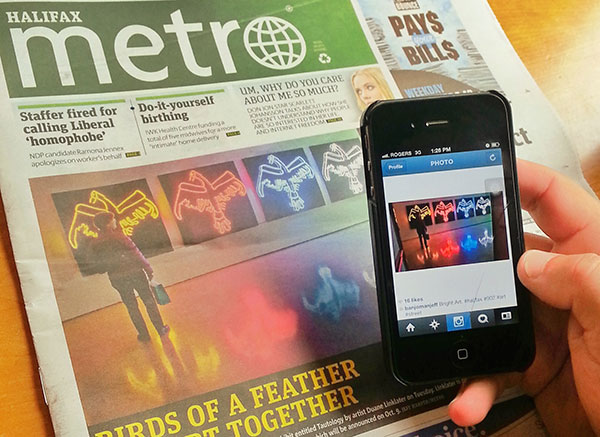The Instagram debate

caption
Jeff Harper, photographer for the Halifax Metro, believes the less an image is filtered, the better for news photography.Is photojournalism under threat from #catsofinstagram and #throwbackthursday?
Amaro or Valencia? Sierra or Sutro? These are some perplexing questions of the digital age. Which filter works best? How do I best share this picture of my morning coffee? Are these glasses on my cat too crooked?
Anyone familiar with these kinds of pictures probably has an Instagram account, and is guilty of asking the same questions. Since its launch in 2010, Instagram has ingrained itself into pop culture, acquiring the appropriate name “iPhoneography.”
The first picture I posted I didn’t actually know how to use it, so it was the back of an airplane seat.Ed Kashi, photographer
“It was actually my then 14 year-old daughter who turned me onto Instagram,” says photographer Ed Kashi. Kashi has just under twenty thousand followers on the app. “It’s kind of sad, actually. The first picture I posted I didn’t actually know how to use it, so it was the back of an airplane seat.”
Now Kashi finds the level of communication Instagram creates to be one of its best features. “There’s this way you can use social media now, especially through Instagram and as a photographer, to conjure up more interest and support for what you’re doing.”
Kashi does a lot of what is sometimes called advocacy journalism, and for him Instagram has become a way to trigger support for certain issues. When he was in Nicaragua working on a story about the kidney disease epidemic among sugar cane workers, he would post photos to his Instagram account where people would comment, show their support, and ask how they could help.
“That to me is what is so exciting. Whether I reach my kids or reach a stranger halfway around the world, I can post an image and it touches them. It makes them or inspires them to make a comment or ask a question,” he says. “The iPhones, through Instagram and social media can be this wonderful conduit to connecting with people.”
While a majority of people on Instagram use it to showcase their outfit of the day or brag about their vegan lunch, news organizations have begun using it as yet another communication platform.
As of Sept. 8, 2013, Instagram had roughly 150 million users. Alexa Clark is a digital strategist and entrepreneur in Toronto with a following of 275 Instagrammers. She sums up the way in which iPhoneography has shaped today’s culture: “My father has a saying, ‘Little brother is watching you,’ with the idea that everyone has a camera in their hand.” Today, almost every phone has a camera and many of them have Instagram or other photo sharing apps.
Touch of a button
It is easy to see why news organizations have embraced Instagram as a way to reach their readers. But Instagram is controversial; adding filters could potentially alter the reality of the photos. The ability to alter a photo at the touch of a button has journalists and readers worried about the authenticity of Instagram images in journalism.
In November 2012 Time magazine put an iPhone photo of Hurricane Sandy on its cover. In March 2013, the New York Times put an Instagram photo of New York Yankee Alex Rodriguez on its front page. iPhoneography and apps like Instagram and Hipstamatic have become an integral part of photojournalism.
So if Instagram has become so popular within the journalism industry, why is it so controversial?
Shauna Rempel is the social media team editor at the Toronto Star. She’s in charge of the Star‘s Instagram which has more than 500 followers. “We’re using it in a variety of ways,” says Rempel. “With live events, the reporter is Instagramming photos and now video through Instagram, and some of them are being tweeted through the Twitter account. Some of those appear on the live blog, and then they get Tweeted again onto Facebook.
“The goal is to further the brand, as much as a journalism organization can have a brand,” says Rempel. “Sort of get our name out there a little bit more and reach out to a group of potential readers who might not be reading us on a regular basis.” Many big names in news are on Instagram: Time, Globe and Mail, BBC, Chicago Sun Times, Huffington Post, National Geographic and Toronto Star.
Kashi was one of five photojournalists assigned by Time magazine to upload live photos of Hurricane Sandy to its Instagram feed in 2012.
“It was absolutely exhilarating and empowering that I could immediately, within minutes of making an image, share that work,” says Kashi. “And then know that people all over the world potentially could be seeing it and could know what was going on.”
Within the last year and a half Kashi has been asked to complete five assignments using his iPhone; three specifically for Instagram. “I wish Time magazine and other publications would deploy this more, I think it’s very exciting,” he says.
Brian Kerrigan, photo editor for The National in Abu Dhabi, says Instagram is two things: “There’s Instagram as a delivery platform, and then there’s Instagram as a photo editing slash manipulating software.”
Instagram, when used as a photo editing tool, causes heat between journalists. In 2011, a year after Instagram kicked off, New York Times photographer Damon Winters won third place in Pictures of the Year International, run by the Donald W. Reynolds Journalism Institute in Missouri. He won for a picture taken with his iPhone and processed through Hipstamatic. The authenticity of the photo became a controversial topic; arguments have been made for and against Winter’s photo.
According to Kerrigan, the key to using Instagram is simple: common sense. “People in general want to have hard and fast rules, but, to use a clichéd phrase, ‘life is a moving target’,” says Kerrigan. “The only kind of rule is that there are always exceptions to the rule. You need to have a certain commitment to straightforward visual processing and handling of an image so that you’re being as factual as visually possible.”
Rempel says the Star does not have an official ethics policy for its Instagram feed, but it is expected that the Instagram account adhere to the same ethical guidelines their photojournalists and reporters do.
Filters are journalism’s main issue with Instagram. While filters like Lo-Fi and Hudson can add some extra contrast or saturation to your photo, they don’t necessarily change the content of the photo; they display it in a more artful way. This is where controversy lies. Nick Stern, a photojournalist and member of the National Press Photographers Association, is one of many who disagree with the use of Instagram in photojournalism. Though he could not be reached for a comment, he has said this in a CNN post:
“Every time a news organization uses a Hipstamatic or Instagram-style picture in a news report, they are cheating us all. It’s not the photographer who has communicated the emotion into the images. It’s not the pain, the suffering or the horror that is showing through. It’s the work of an app designer in Palo Alto who decide that a nice shallow focus and dark faded border would bring out the best in the image.”
Alexa Clark, digital strategist and social entrepreneur in Toronto, believes strict views on app use are grounded in traditional photojournalism but a bit out-dated. “That’s rooted in the ethics of ensuring what’s being represented is accurate, and is still incredibly important,” she says. “The truth is, it might be the right thing to form an ethical standpoint to establish those guidelines, but I don’t think it’s going to be sustainable.”
Photographer Ed Kashi holds the same idea, and says maintaining traditional, old school photojournalism ethics is not always possible because standards have changed over the last few years, and continue to change.
Clear distinction
“There are images and photos now being published that six or seven years ago would have been thrown out because they would have been viewed as too manipulated. Clearly there’s a shift going on, and I have to believe Hipstamatic and Instagram filters are a part of that.”
Apps have brought change to the photojournalism industry, and with this a shift in quality standards is inevitable. To photojournalists like Kashi, though, that does not mean the end of an ethics code, but an adoption of a new, modern one.
“We certainly need to hold onto certain standards, there’s no question about that,” he says. “There needs to be a clear distinction between what is journalism and fact based as opposed to art or work that is really more about the creator’s vision or opinions.”
Graeme Roy, photo and video director for the Canadian Press has almost 2000 followers. Instagram, he says, is just another tool. Roy disconnects the controversy between filters and photojournalism. “The truth of a photo is in the eye of the beholder, it isn’t so much in the eye of the person who shot it,” says Roy. “I think that it boils down to the honesty and integrity and the truthfulness of the photographer. The tools they’re using, they’re just tools.”
Roy lays responsibility on the photographer to be honest and transparent with viewers and says the debate over the use of Instagram in photojournalism is misplaced. Just because photos of cats in costumes and Holi celebrations are being delivered through the same platform doesn’t mean they are held to the same standard.
“I think that a lot of these people are throwing everything into one big pile,” says Roy, “Associating a photographer like David Guttenfelder (Associated Press Chief Photographer, Asia) with somebody who is a 16 year-old who’s shooting selfies or pictures of their plate of sushi and somehow this is the same thing. And it’s clearly not.”
Richard Hernandez, a multimedia journalist and professor at UC Berkeley, believes adding filters to mobile photos is no different than choosing film 20 years ago.
“The choice of film was actually a choice of filter. There was a Fuji film called Velvia, and that was known to photographers to have a greenish tint,” says Hernandez. “Everybody knew the Kodak Kodachrome was this warm, reddish-orange tone.”
Jeff Harper, photographer for the Halifax Metro, says there are ways to avoid heavy filtering for news images on Instagram. He recommends other apps, including Adobe’s Photoshop or Snapseed.
Part of the reason for doing this is to maintain readers’ trust if journalists are going to be using Instagram, says Hernandez. “Photojournalism is kind of the last bastion of veracity and truth in photography. Photojournalists have the utmost responsibility to represent and present the cleanest and purest form of photography back to the public.”
Journalists are following their audience onto social media platforms.. It is up to journalists to ensure the information remains accurate and honest.
It’s as Graeme Roy, photo and video director for the Canadian Press, says: “If Hemingway were alive and tweeting, he would still be Hemingway. He’s not like other people who tweet nonsense. The content can still, and does still speak for itself and I think that it always will.”

